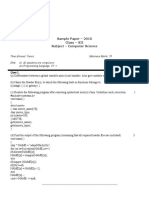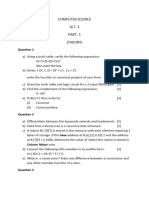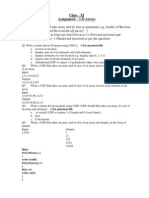Classes Assignment
Uploaded by
Niti AroraClasses Assignment
Uploaded by
Niti AroraComputer Science (083) Lesson Plan : Classes & Objects
COMPUTER SCIENCE
CLASS XII
Assignment : Classes, Objects & Constructor (2009-10)
1. Define a class named Housing in C++ with the following descriptions :
private members
reg_no integers (Ranges 10-1000)
name char array
type character
cost float
public members
• function Read_data() to read an object of housing type.
• function display() to display the details of an object.
Define a function draw_nos() which takes an array of Housing as parameter, chooses and
displays the details of 2 houses selected randomly from the array. Use random function to
generate the registration no.
2. Define a class named Cricket in C++ with the following descriptions :
private members
Target_scope int
Overs_bowled int
Extra_time int
Penalty int
cal_panalty() a member function to calculate penalty as follows :
if Extra_time <=10 , penalty =1
if Extra_time >10 but <=20, penalty =2
otherwise, penalty =5
public members
• a function extradata() to allow user to enter values for
target_score,overs_bowled,extra_time.
• a function dispdata() to follow user to view the contents of all data members.
3. Define a class named Directory in C++ with the following descriptions :
private members
docunames string (documents name in directory)
freespace long (total number of bytes available in directory )
occupied long (total number of bytes available in directory)
public members
newdocuentry() a function to accept values of docunames,freespace &
occupied from user
retfreespace() a function that return the value of total kilobytes available.
(1 KB=1024 b)
showfiles() a function that displays the names of all the documents in
directory.
Submitted by Niti Arora
Computer Science (083) Lesson Plan : Classes & Objects
4. Define a class named Publisher in C++ with the following descriptions :
private members
Id long
title 40 char
author 40 char
price , stockqty double
stockvalue double
valcal() A function to find price*stockqty with double as return
type
Public members
• a constructor function to initialize price , stockqty and stockvalue as 0
• Enter() function to input the idnumber , title and author
• Takestock() function to increment stockqty by N(where N is passed as argument to
this function) and call the function valcal() to update the stockvalue().
• sale() function to decrease the stockqty by N (where N is sale quantity passed
• to this function as argument) and also call the function valcal() to update the
• stockvalue
• outdata() function to display all the data members on the screen.
5. Define a class named Serial in C++ with the following descriptions :
private members
serialcode int
title 20 char
duration float
noofepisodes integer
Public members
• a constructor function to initialize duration as 30 and noofepisodes as 10.
• Newserial() function to accept values for serialcode and title.
• otherentries() function to assign the values of duration and noofepisodes with
• the help of corresponding values passed as parameters to this function.
• dispdata() function to display all the data members on the screen.
6. Considering the following specifications :
Structure name data type size
• Name_first char array 40
• mid char array 40
• last char array 60
Structure Phone
• area char array 4
• Exch char array 4
• numb char array 6
Class name P_rec Data Type
• name Name
• phone Phone
Submitted by Niti Arora
Computer Science (083) Lesson Plan : Classes & Objects
Member functions:
• Define constructor (outside the class P_rec) that accepts the values of data
• members from the user.
• Define the display_rec (outside the class P_rec) that shows the current values .
• Declare structures in C++ for Name and Phone . Declare the class P_rec.
7. Define a class Competition in C++ with the following descriptions:
Data Members
Event_no integer
Description char(30)
Score integer
qualified char
Member functions
• A constructor to assign initial values Event_No number as 101,Description as “State
level” Score is 50 , qualified ‘N’.
• Input() To take the input for event_no,description and score.
• Award(int) To award qualified as ‘Y’, if score is more than the cutoffscore passed as
argument to the function else ‘N’.
• Show() To display all the details.
8. Declare a class bank to represent bank account of 10 customers with the following data
members: name of depositor, account number, type of account(s for savings and c for current
account), balance amount. The class also contains the following member functions:
• To initialize data members.
• To deposit money
• To withdraw money after checking minimum balance (say 1000)
• To display the data members on screen.
9. Answer the questions(i) and (ii) after going through the following class :
class Exam
{
int year;
public :
Exam(int y) { year=y; }
Exam(Exam &t);
}
(i) Create an object, such that it invokes constructor 1.
(ii) Write complete definition for constructor 2.
Submitted by Niti Arora
Computer Science (083) Lesson Plan : Classes & Objects
Q. 10 Describe the methods of accessing data members and member
functions of a class in the following cases:
i. Inside the main program
ii. Inside a member function of the same class
iii.Inside a member function of another class.
Q. 11Define a class student with the following specifications:
Private members:
rollno integer
name character array of size 20
class_st character array of size 8
marks integer array of size 5
percentage float
calculate that calculates overall percentage marks and returns the
percentage.
Public Members:
readmarks reads marks and invokes the calculate function
displaymarks prints the data.
Q. 12 hat are the advantages and disadvantages of inline functions?
Q .13Given the following C++ code, answer the questions i and ii:
class readbook
{
public:
readbook( ) //Function1
{
cout<<”Open the Book”<<endl;
}
void readchapter( ) //Function 2
{
cout<<”Reading chapter one”<<endl;
}
~readbook( ) //Function 3
{
cout<<”Close the book”<<endl;
}
};
1. In OOP, what is Function 1 referred as and when does it get
invoked/called?
2. In OOP, what is Function 3 referred as and when does it get
invoked/called?
Q. 14 efine the following:
1. Default Constructor
2. Copy Constructor
Q. 15. Distinguish between the following two statements:
Submitted by Niti Arora
Computer Science (083) Lesson Plan : Classes & Objects
time T1(13, 10, 25); //statement 1
time T1 = time(13,10,25); //statement 2
Submitted by Niti Arora
You might also like
- Sumita Arora Class 12 C++ Classes and ObjectsNo ratings yetSumita Arora Class 12 C++ Classes and Objects20 pages
- Advanced C++ Interview Questions You'll Most Likely Be AskedFrom EverandAdvanced C++ Interview Questions You'll Most Likely Be AskedNo ratings yet
- Practice Assignment - Classes and ObjectsNo ratings yetPractice Assignment - Classes and Objects4 pages
- Object-Oriented Programming by C++ Lec 5No ratings yetObject-Oriented Programming by C++ Lec 538 pages
- Class and Object Assignment: Private MembersNo ratings yetClass and Object Assignment: Private Members12 pages
- Q1. Question To Define A Class and Its Member FunctionNo ratings yetQ1. Question To Define A Class and Its Member Function2 pages
- Bca-Hc-4036: Object Oriented Programminf in C++No ratings yetBca-Hc-4036: Object Oriented Programminf in C++4 pages
- Sample Paper - 2010 Class - XII Subject - Computer ScienceNo ratings yetSample Paper - 2010 Class - XII Subject - Computer Science7 pages
- Sample Paper - 2009 Class - XII Subject - COMPUTER SCIENCE (083) Time: 3 Hrs Max - Marks:70 Q.1)No ratings yetSample Paper - 2009 Class - XII Subject - COMPUTER SCIENCE (083) Time: 3 Hrs Max - Marks:70 Q.1)8 pages
- Assignment Comp. SC Class XII: Classes and ObjectsNo ratings yetAssignment Comp. SC Class XII: Classes and Objects3 pages
- Write Instructions Here. Write The Question Here Mark S 1 - A - 2 B 1 C 2No ratings yetWrite Instructions Here. Write The Question Here Mark S 1 - A - 2 B 1 C 28 pages
- Class:10 Subject: Computer Applications: LS 10. Constructors Important PointsNo ratings yetClass:10 Subject: Computer Applications: LS 10. Constructors Important Points7 pages
- Object Oriented Programming - Nabia KhalidNo ratings yetObject Oriented Programming - Nabia Khalid4 pages
- Final Model Kit Class XII CBSE COMPUTER SCIENCENo ratings yetFinal Model Kit Class XII CBSE COMPUTER SCIENCE10 pages
- Lab Journal 8 23042024 031010pm 24042024 052706pmNo ratings yetLab Journal 8 23042024 031010pm 24042024 052706pm9 pages
- Introduction to Python Programming: Do your first steps into programming with pythonFrom EverandIntroduction to Python Programming: Do your first steps into programming with pythonNo ratings yet
- Python Advanced Programming: The Guide to Learn Python Programming. Reference with Exercises and Samples About Dynamical Programming, Multithreading, Multiprocessing, Debugging, Testing and MoreFrom EverandPython Advanced Programming: The Guide to Learn Python Programming. Reference with Exercises and Samples About Dynamical Programming, Multithreading, Multiprocessing, Debugging, Testing and MoreNo ratings yet
- Sample Paper of Computer Science Class 12No ratings yetSample Paper of Computer Science Class 125 pages
- Data Structures and Object Oriented Programming in C++No ratings yetData Structures and Object Oriented Programming in C++13 pages
- 1713678514kvs Study Material Xii Cs NotesNo ratings yet1713678514kvs Study Material Xii Cs Notes154 pages
- Class 12 Computer Science Notes and Questions.82% (11)Class 12 Computer Science Notes and Questions.135 pages
- Blueprint of Question Paper For The Year 2013No ratings yetBlueprint of Question Paper For The Year 20132 pages
- Sample of Project Report For Class 11 Students75% (8)Sample of Project Report For Class 11 Students10 pages
- Guy Wire Hardware For Set # 1 at Elev 75.00 FTNo ratings yetGuy Wire Hardware For Set # 1 at Elev 75.00 FT1 page
- Flat Head Syndrome (Positional Plagiocephaly) - Johns Hopkins All Children's HospitalNo ratings yetFlat Head Syndrome (Positional Plagiocephaly) - Johns Hopkins All Children's Hospital10 pages
- Definition and Objective of An Assurance EngagementNo ratings yetDefinition and Objective of An Assurance Engagement3 pages
- Issues in Teacher Leadership Review - Phlong PaulinaNo ratings yetIssues in Teacher Leadership Review - Phlong Paulina2 pages
- Instruction Manual: Autoclaves & SterilizersNo ratings yetInstruction Manual: Autoclaves & Sterilizers61 pages
- DTC Agreement Between Cyprus and United StatesNo ratings yetDTC Agreement Between Cyprus and United States30 pages
- Cadbury Presentation - Group 3 - Consumer Behavior0% (1)Cadbury Presentation - Group 3 - Consumer Behavior28 pages
- Chapter 8 - Notes Payable and Debt Restructuring: Problem 8-7No ratings yetChapter 8 - Notes Payable and Debt Restructuring: Problem 8-73 pages
- Detection Systems For Reducing The Risk of Hydrogen Fires - Chemical Engineering - Page 3No ratings yetDetection Systems For Reducing The Risk of Hydrogen Fires - Chemical Engineering - Page 34 pages
- MANGO LEAF DISEASE DETECTION USING IMAGE PROCESSING TECHNIQUE - farhanPSM1No ratings yetMANGO LEAF DISEASE DETECTION USING IMAGE PROCESSING TECHNIQUE - farhanPSM147 pages
- Advanced C++ Interview Questions You'll Most Likely Be AskedFrom EverandAdvanced C++ Interview Questions You'll Most Likely Be Asked
- Q1. Question To Define A Class and Its Member FunctionQ1. Question To Define A Class and Its Member Function
- Sample Paper - 2010 Class - XII Subject - Computer ScienceSample Paper - 2010 Class - XII Subject - Computer Science
- Sample Paper - 2009 Class - XII Subject - COMPUTER SCIENCE (083) Time: 3 Hrs Max - Marks:70 Q.1)Sample Paper - 2009 Class - XII Subject - COMPUTER SCIENCE (083) Time: 3 Hrs Max - Marks:70 Q.1)
- Assignment Comp. SC Class XII: Classes and ObjectsAssignment Comp. SC Class XII: Classes and Objects
- Write Instructions Here. Write The Question Here Mark S 1 - A - 2 B 1 C 2Write Instructions Here. Write The Question Here Mark S 1 - A - 2 B 1 C 2
- Class:10 Subject: Computer Applications: LS 10. Constructors Important PointsClass:10 Subject: Computer Applications: LS 10. Constructors Important Points
- Advanced C Concepts and Programming: First EditionFrom EverandAdvanced C Concepts and Programming: First Edition
- Introduction to Python Programming: Do your first steps into programming with pythonFrom EverandIntroduction to Python Programming: Do your first steps into programming with python
- "C Programming for Beginners: A Step-by-Step Guide"From Everand"C Programming for Beginners: A Step-by-Step Guide"
- Python Advanced Programming: The Guide to Learn Python Programming. Reference with Exercises and Samples About Dynamical Programming, Multithreading, Multiprocessing, Debugging, Testing and MoreFrom EverandPython Advanced Programming: The Guide to Learn Python Programming. Reference with Exercises and Samples About Dynamical Programming, Multithreading, Multiprocessing, Debugging, Testing and More
- Data Structures and Object Oriented Programming in C++Data Structures and Object Oriented Programming in C++
- Flat Head Syndrome (Positional Plagiocephaly) - Johns Hopkins All Children's HospitalFlat Head Syndrome (Positional Plagiocephaly) - Johns Hopkins All Children's Hospital
- Definition and Objective of An Assurance EngagementDefinition and Objective of An Assurance Engagement
- Issues in Teacher Leadership Review - Phlong PaulinaIssues in Teacher Leadership Review - Phlong Paulina
- Cadbury Presentation - Group 3 - Consumer BehaviorCadbury Presentation - Group 3 - Consumer Behavior
- Chapter 8 - Notes Payable and Debt Restructuring: Problem 8-7Chapter 8 - Notes Payable and Debt Restructuring: Problem 8-7
- Detection Systems For Reducing The Risk of Hydrogen Fires - Chemical Engineering - Page 3Detection Systems For Reducing The Risk of Hydrogen Fires - Chemical Engineering - Page 3
- MANGO LEAF DISEASE DETECTION USING IMAGE PROCESSING TECHNIQUE - farhanPSM1MANGO LEAF DISEASE DETECTION USING IMAGE PROCESSING TECHNIQUE - farhanPSM1
















































































































